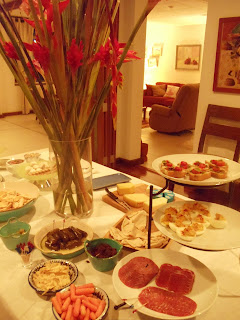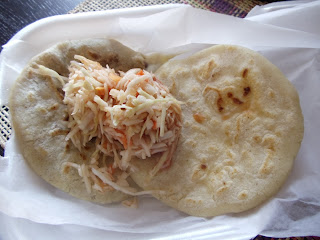My 21-month-old son has pink, chubby cheeks and it is kind of obvious that he is a good eater just by looking at him. Of course he has his off days, when his appetite decreases, but who doesn't? People are always asking me what kinds of meals I make him, so I decided to start sharing some of his favorite recipes, in case you'd like to make them for your kiddlings.
Please don't let your possible prejudice or misconceptions about certain foods ruin your child's interest and ability to try new things. Instead of having an "I don't like _____" attitude, how about having an open mind toward food? Nothing makes me angrier than hearing a child (or an adult, for that matter!) say "I don't like that. Yuck!" To me it shows a lack of character and well-roundedness. I believe an open mind toward new foods makes for more interesting and agreeable people. The kinds of people I'd like to have around my dinner table.
This open-minded attitude definitely applies to tofu. Whenever I tell parents that we eat tofu at home, many cringe and look at me funny, as if I were some kind of organic-food eating, vegetarian, tree hugging hippie. I think I've established in this blog that I do not fit that profile. Actually, we eat tofu because we know how to make it taste great, and it is extremely healthy.
In Beijing I tried something called
stinky tofu. Ok, so this may be an extreme since it is fermented tofu and has the smell of, well, yes, putrid tofu. I'm not suggesting you take it to this level. All I'm saying is give my recipe a try and help your toddler enjoy a wonderful new dish. And besides, the Chinese seem to live forever and ever, so they may have something here. In fact, tofu is incredibly healthy. It has tons of iron, protein, omega 3 fatty acids, calcium, and a lot of other good stuff. Check out this
website for more information on the health benefits of tofu.
If you think you might be giving your toddler too much meat or chicken, then you probably are. Trust, me. Give this a try. After all, because tofu can magically take the taste of whatever you cook it with, it'll only be as good as you make it. My son loves grabbing the chunky pieces of veggies and tofu and putting them into his mouth - he can pick them up with his fingers (has been doing so since he was six months old), and now that he's using a fork, he's able to eat them this way as well. It works for him developmentally and nutritionally.
Chunky Tofu and Zucchini
1 pack firm tofu
Extra virgin olive oil
1 clove garlic
1 medium white onion
2 medium tomatoes
1 zucchini
1 can chicken broth (get the good stuff w/o MSG)
Kosher salt to taste (I love the texture of kosher salt)
Herbs de Provence to taste
Saute the garlic in a bit of extra virgin olive oil, then add the diced onions, diced tomatoes, sliced zucchini, and finally the cubes of tofu. Season with kosher salt* to taste, herbs de provence, and pour 1/4 of the chicken broth to let everything steam. Pour the rest of the content of the chicken broth in 1/4 intervals and let steam for about 20 minutes. Serve on a bed of brown rice.
*I didn't start adding salt to my son's food until he was around one year old. Now he eats what we eat, which is with a bit of salt.

















































